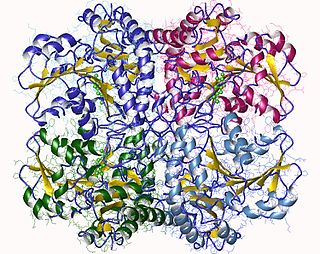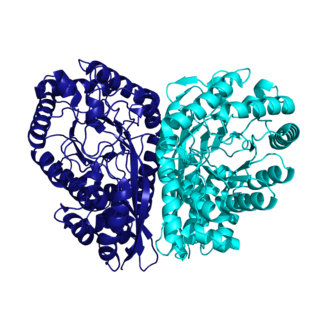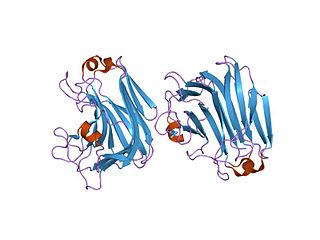Related Research Articles

Adenylosuccinate lyase is an enzyme that in humans is encoded by the ADSL gene.

The enzyme cystathionine γ-lyase (EC 4.4.1.1, CTH or CSE; also cystathionase; systematic name L-cystathionine cysteine-lyase (deaminating; 2-oxobutanoate-forming)) breaks down cystathionine into cysteine, 2-oxobutanoate (α-ketobutyrate), and ammonia:

The transsulfuration pathway is a metabolic pathway involving the interconversion of cysteine and homocysteine through the intermediate cystathionine. Two transsulfurylation pathways are known: the forward and the reverse.

Cystathionine beta-lyase, also commonly referred to as CBL or β-cystathionase, is an enzyme that primarily catalyzes the following α,β-elimination reaction
The enzyme cysteine-S-conjugate β-lyase (EC 4.4.1.13) catalyzes the chemical reaction

The enzyme methylaspartate ammonia-lyase (EC 4.3.1.2) catalyzes the chemical reaction
The enzyme chondroitin AC lyase catalyzes the chemical reaction
The enzyme chondroitin B lyase catalyzes the following process:
The enzyme DNA-(apurinic or apyrimidinic site) lyase, also referred to as DNA-(apurinic or apyrimidinic site) 5'-phosphomonoester-lyase or DNA AP lyase catalyzes the cleavage of the C-O-P bond 3' from the apurinic or apyrimidinic site in DNA via β-elimination reaction, leaving a 3'-terminal unsaturated sugar and a product with a terminal 5'-phosphate. In the 1970s, this class of enzyme was found to repair at apurinic or apyrimidinic DNA sites in E. coli and in mammalian cells. The major active enzyme of this class in bacteria, and specifically, E. coli is endonuclease type III. This enzyme is part of a family of lyases that cleave carbon-oxygen bonds.
The enzyme hyaluronate lyase catalyzes the chemical reaction
The enzyme inulin fructotransferase (DFA-I-forming) catalyzes the following process:
The enzyme inulin fructotransferase (DFA-III-forming) catalyzes the following process:
The enzyme levan fructotransferase (DFA-IV-forming) catalyzes the following process:
Pectin lyase, also known as pectolyase, is a naturally occurring pectinase, a type of enzyme that degrades pectin. It is produced commercially for the food industry from fungi and used to destroy residual fruit starch, known as pectin, in wine and cider. In plant cell culture, it is used in combination with the enzyme cellulase to generate protoplasts by degrading the plant cell walls.

The enzyme mannuronate-specific alginate lyase catalyzes the degradation of alginate into various monosaccharide and polysaccharide products:
The enzyme xanthan lyase catalyzes the following process:
(S)-hydroxynitrile lyase (EC 4.1.2.47, (S)-cyanohydrin producing hydroxynitrile lyase, (S)-oxynitrilase, (S)-HbHNL, (S)-MeHNL, hydroxynitrile lyase, oxynitrilase, HbHNL, MeHNL, (S)-selective hydroxynitrile lyase, (S)-cyanohydrin carbonyl-lyase (cyanide forming), hydroxynitrilase) is an enzyme with systematic name (S)-cyanohydrin lyase (cyanide forming). This enzyme catalyses the interconversion between cyanohydrins and the carbonyl compounds derived from the cyanohydrin with free cyanide, as in the following two chemical reactions:
UDP-N-acetylglucosamine 4,6-dehydratase (configuration-inverting) (EC 4.2.1.115, FlaA1, UDP-N-acetylglucosamine 5-inverting 4,6-dehydratase, PseB, UDP-N-acetylglucosamine hydro-lyase (inverting, UDP-2-acetamido-2,6-dideoxy-β-L)arabino-hex-4-ulose-forming)) is an enzyme with systematic name UDP-N-acetyl-α-D-glucosamine hydro-lyase (inverting; UDP-2-acetamido-2,6-dideoxy-β-L-arabino-hex-4-ulose-forming). This enzyme catalyses the following chemical reaction
Gellan lyase is an enzyme with systematic name gellan β-D-glucopyranosyl-(1→4)-D-glucopyranosyluronate lyase. This enzyme catalyses the following process:
References
- Courtois B, Courtois J (1997). "Identification of glucuronan lyase from a mutant strain of Rhizobium meliloti". Int. J. Biol. Macromol. 21 (1–2): 3–9. doi:10.1016/S0141-8130(97)00033-0. PMID 9283009.